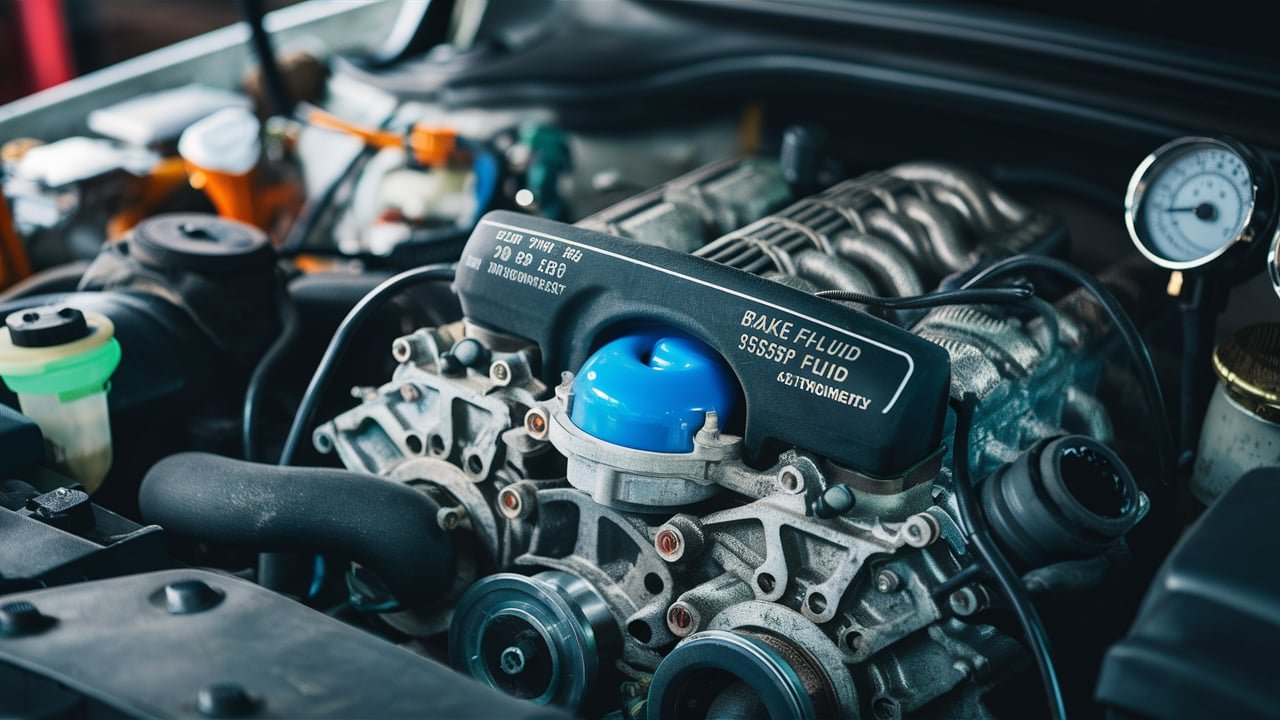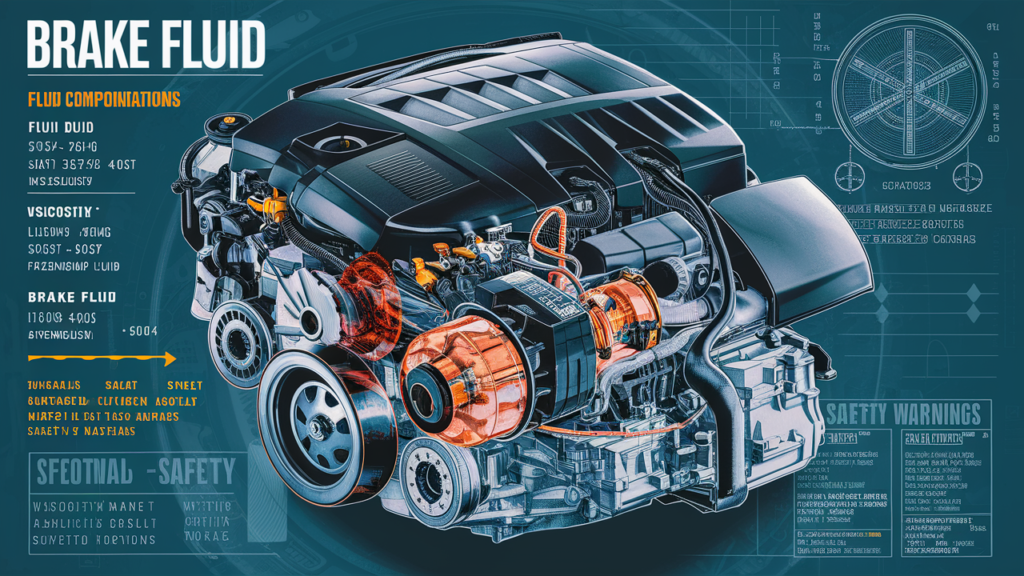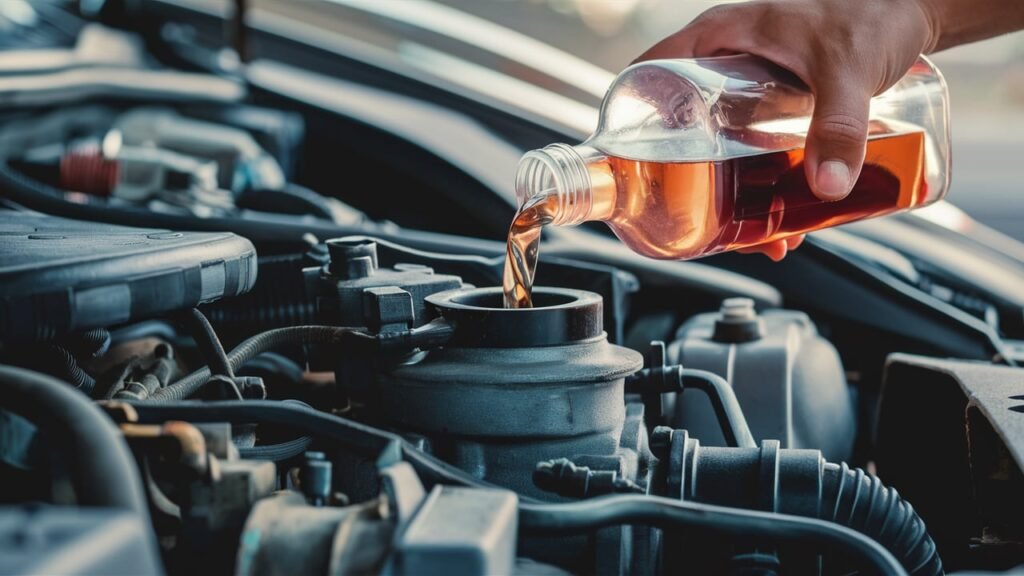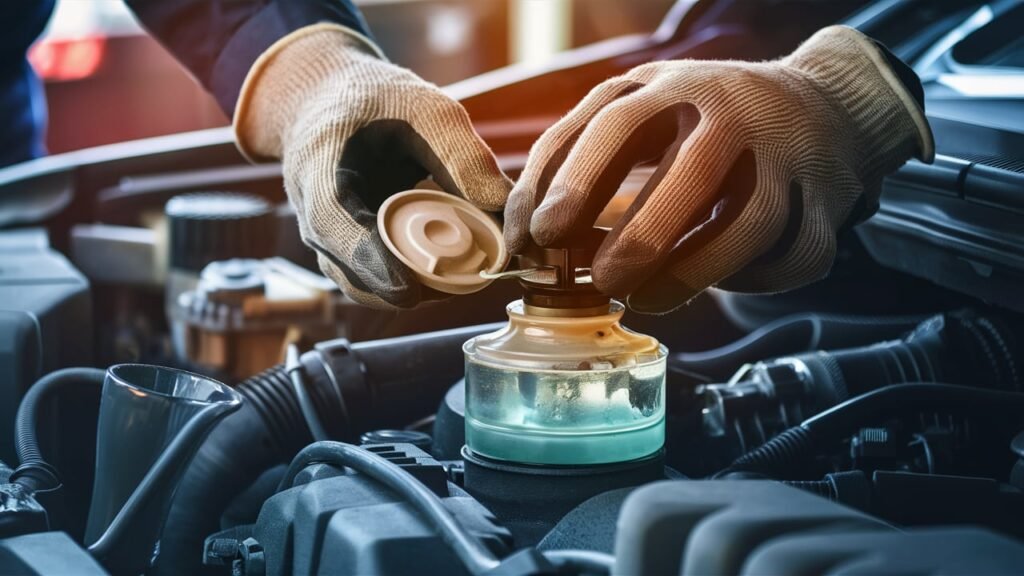
Understanding Car Engine Brake Fluid Specifications: A Technical Guide
Brake fluid specifications are crucial for ensuring the proper functioning of a vehicle’s braking system. Here are some key specifications and standards to consider:
- Federal Motor Vehicle Safety Standards (FMVSS):
- DOT 3: The most common grade, suitable for most passenger vehicles.
- DOT 4: Suitable for vehicles with ABS and ESP systems, as it has a higher boiling point.
- DOT 5: Silicone-based fluid, used in specific applications where water resistance and low corrosion are important.
- International Standards Organization (ISO):
- Class 3: Similar to DOT 3.
- Class 4: Similar to DOT 4.
- Class 5.1: Similar to DOT 5.1.
- Class 6: Not commonly used.
- Society of Automotive Engineers (SAE):
- SAE J1703: Similar to DOT 3.
- SAE J1704: Similar to DOT 4.
- SAE J1705: Similar to DOT 5.1.
- Viscosity:
- Measured at 100°C (212°F) and -40°C (-40°F).
- Higher viscosity at low temperatures can affect ABS performance.
- Base Components:
- Glycol-ether based: Most modern brake fluids.
- Silicone-based: Used in specific applications where water resistance and low corrosion are important.
- Colour Requirements:
- Clear to Amber: Ether-based fluids.
- Purple: Silicone-based fluids.
- Boiling Point:
- Dry Boiling Point: The temperature at which the fluid boils without water absorption.
- Wet Boiling Point: The temperature at which the fluid boils with 3.7% water absorption.
- pH Value:
- Acidity/Basicity: A measure of the fluid’s corrosiveness. Most brake fluids have a pH value close to 7.0, which is neutral.
- Compatibility:
- Mixing Brake Fluids: Not recommended, as it can lead to contamination and reduced performance.
- DOT 5: Not compatible with other DOT grades.
- Packaging and Storage:
- Foil Caps: Ensure they are intact to prevent moisture contamination.
- Dispose of Unused Fluid: After opening, as it can degrade over time.
These specifications and standards ensure that brake fluids meet the necessary criteria for safe and effective braking performance in various vehicles and environments.
Unraveling the intricate world of car engine brake fluid specifications is not merely a task for the curious; it stands as a fundamental pillar in ensuring safe and optimized vehicle performance. To engineers, mechanics, and automotive enthusiasts alike, delving into the meticulous details of brake fluid requirements can mean the difference between flawless braking control and unforeseen system failures.
Through a lens of precision and technical proficiency, this guide aims to illuminate the critical aspects that define these specifications, transcending surface knowledge to impart an in-depth understanding vital for every automotive professional.
Within these pages lie an exploration of viscosity ratings, deciphering their role in shaping brake system efficiency. Embracing the complexities of high versus low viscosity’s impact on performance opens doors to nuanced insights on brake fluid behavior under varying conditions.

As i traverse through discussions on DOT 3, DOT 4, and DOT 5 distinctions, compositions unravel before us like a blueprint guiding application choices with methodical precision. Each dotting point underscores a crucial delineation among these fluid variants — a stepping stone toward mastery in discerning which formulation best suits specific vehicular demands.
Let your technical aptitude soar as we untangle the web of brake fluid characteristics with unwavering detail in this immersive journey towards expertise in car engine brake fluid specifications.
Understanding Car Engine Brake Fluid Specifications.
Brake fluid viscosity ratings play a crucial role in ensuring optimal brake system performance. Viscosity, measured in centistokes (cSt), indicates the fluid’s resistance to flow at different temperatures.
A common scenario is comparing DOT 3 with DOT 5 brake fluids—where DOT 3 typically has a lower minimum wet boiling point but higher viscosity than DOT 5. This contrast highlights how understanding these ratings can directly impact braking efficiency under varying conditions.
High viscosity brake fluids, such as DOT 3, provide greater protection against wear and corrosion due to their thicker consistency. However, they might be less suitable for vehicles operating in extremely cold temperatures because of their slower flow rate.
On the other hand, low viscosity options like DOT 5 offer excellent performance in cold climates but may not provide the same level of protection at high temperatures compared to higher viscosity fluids. Engineers and mechanics need to consider these dynamics when selecting the most appropriate brake fluid for a specific vehicle or application.

DOT classifications represent different formulations and intended uses for brake fluids. For instance, while both DOT 3 and DOT 4 are glycol-based fluids suitable for most vehicles on the road today, DOT 5 stands out as a silicone-based alternative often used in classic cars or applications requiring a non-hygroscopic fluid.
The distinction lies not only in composition but also in compatibility—mixing different types could lead to compromised braking performance. Understanding these specifications allows automotive enthusiasts to make informed decisions based on their vehicle’s requirements and operational conditions.
Key Components of Brake Fluid Specifications.
Brake fluid specifications encompass a mix of key components crucial for ensuring optimal brake system performance and longevity. Two primary types of glycol ethers – polyethylene glycol (PEG) and monoethylene glycol (MEG) – serve as the foundation of brake fluid formulations.
These glycol ethers are responsible for effectively transferring force from the master cylinder to the brake calipers while maintaining stability across varying temperatures. For instance, PEG-based fluids are known for their hygroscopic nature, absorbing moisture that may seep into the brake system over time, safeguarding against water accumulation that could compromise braking efficiency.
Corrosion inhibitors represent another integral component in brake fluid compositions. These additives shield critical brake components like steel lines, fittings, and cylinders from corrosive damage caused by moisture or other environmental factors.
A common example is 2-ethylhexanoic acid acting as a corrosion inhibitor in combination with other anti-wear agents to protect metallic surfaces within the braking system. Understanding how these inhibitors work synergistically with glycol ethers sheds light on their role in preserving overall brake system integrity under diverse operating conditions.
Temperature sensitivity profoundly impacts the choice of appropriate brake fluid variants based on their constituent components. In regions experiencing extreme cold or heat fluctuations, selecting a suitable fluid with a balanced viscosity index becomes imperative.
For instance, formulations incorporating MEG exhibit superior performance at low temperatures due to their enhanced flow properties compared to PEG-oriented fluids. Conversely, during high-temperature operation, PEG-based fluids might offer more stable vapor pressure characteristics essential for preventing vapor lock issues within the hydraulic braking circuitry.
Careful consideration of temperature-dependent behaviors aids in tailoring brake fluid selections to specific operational requirements, ensuring reliable braking performance across various driving scenarios.
Testing and Compliance Standards.
In the realm of brake fluid specifications, ensuring adherence to rigorous testing procedures and compliance standards is paramount in guaranteeing optimal braking performance and safety.
Testing procedures such as those outlined in ASTM D3306 play a crucial role in determining whether a brake fluid formulation meets specified benchmarks for performance and reliability. These tests assess vital aspects like boiling points, viscosity, and corrosion resistance to confirm that the brake fluid can withstand the demanding conditions within a vehicle’s braking system.
Moreover, organizations like the FMVSS (Federal Motor Vehicle Safety Standards) and SAE (Society of Automotive Engineers) establish stringent compliance regulations governing the testing and labeling requirements for brake fluids.
By adhering to these comprehensive standards, manufacturers ensure that their products undergo thorough evaluation to meet quality benchmarks essential for safe operation. Compliance with such regulations not only instills confidence in consumers but also underscores the industry’s commitment to upholding high safety standards across all vehicles on the road.

The importance of following recommended testing standards cannot be overstated, as deviations from these guidelines may compromise braking efficiency and overall system integrity. For instance, an insufficiently tested or non-compliant brake fluid might lead to decreased performance under high temperatures or cause corrosion within the braking components over time.
By prioritizing adherence to established testing protocols, manufacturers and users alike can have greater certainty in the reliability and effectiveness of the brake fluid being employed in their vehicles’ braking systems.
Through a steadfast commitment to systematic testing procedures and stringent compliance measures set forth by respected organizations like FMVSS and SAE, stakeholders in the automotive industry uphold a collective dedication to ensuring optimal braking safety.
The conscientious application of these standardized evaluations serves as a cornerstone for maintaining consistent quality across various types of brake fluids available on the market.
Ultimately, by aligning with these testing and compliance standards, engineers, mechanics, and automotive enthusiasts fortify their efforts towards enhancing overall vehicle safety and performance through informed decision-making regarding brake fluid specifications.
Compatibility with Different Brake Systems.
Selecting the right brake fluid is crucial when considering the compatibility with various brake systems such as ABS (Anti-lock Braking System) and ESP (Electronic Stability Program). These modern braking systems have specific requirements due to their advanced functionalities, making it essential to choose a fluid that meets those demands.
For instance, ABS systems are known for their rapid response in preventing wheel lock-up during hard braking. To ensure optimal performance, they require a brake fluid that maintains stability under high pressure conditions, making compatibility a critical factor.
Mixing different types or grades of brake fluids can have detrimental effects on system integrity, especially in advanced brake systems like ESP. Incompatibility issues may arise when dissimilar fluids with varying chemical compositions react adversely, potentially leading to reduced braking efficiency or even system failure.
It is imperative to adhere to manufacturer recommendations and industry standards to prevent any negative consequences that could compromise safety on the road.

Guidelines for selecting a compatible brake fluid depend on the specific requirements of each brake system. For example, ESP systems often work best with synthetic-based brake fluids that operate effectively across a wide temperature range while maintaining consistent viscosity.
Understanding the nuances of different brake systems and their corresponding fluid needs ensures that the braking components function harmoniously, providing reliable stopping power when needed most. By following system-specific guidelines and utilizing compatible fluids, drivers can enhance overall safety and performance on the road.
Maintenance Considerations and Recommendations.
Proper maintenance of brake fluid is crucial for ensuring the effectiveness and longevity of a vehicle’s braking system. Checking and maintaining optimal levels of brake fluid should be a routine practice, especially for individuals like mechanics and automotive enthusiasts concerned with vehicle performance.
To start, it is essential to locate the brake fluid reservoir typically placed near the firewall on the driver’s side under the hood. Utilizing a clean rag, wipe off any dirt or debris from the reservoir cap before unscrewing it gently to inspect the fluid level. The level should align with the “full” marking; if not, topping up with the recommended type of brake fluid is necessary.
Routine inspections play a vital role in detecting early signs of contamination or degradation within the brake fluid. These checks can indicate water absorption, which compromises the fluid’s boiling point and leads to possible corrosion in metal components.
Mechanics may perform simple tests using test strips designed to measure moisture content in brake fluid accurately. Once contamination or degradation is identified, taking proactive steps such as flushing out old brake fluid becomes imperative. Following manufacturer guidelines regarding intervals for changing brake fluid helps maintain optimal performance levels within the braking system.

When changing or flushing out old brake fluid, mechanics should adhere strictly to manufacturer recommendations and specifications relevant to the vehicle being serviced. Different vehicles may have varying requirements based on factors like ABS systems or specific formulations needed for compatibility with certain components.
For example, modern vehicles equipped with ABS demand a higher-performing DOT 4 or DOT 5-rated brake fluid due to their advanced braking mechanisms that depend on consistent hydraulic pressure transmission during anti-lock braking events.
Implementing these proper maintenance practices ensures that engineers, mechanics, and automotive enthusiasts uphold safety standards while optimizing their vehicles’ braking performance for both daily commutes and high-performance driving scenarios.
Conclusion.
In conclusion, understanding car engine brake fluid specifications is crucial for engineers, mechanics, and automotive enthusiasts to ensure optimal performance and safety of the braking system.
By delving into the intricacies of viscosity ratings, components, testing standards, compatibility factors, and maintenance considerations discussed in this technical guide, professionals in the automotive industry can make informed decisions regarding brake fluid selection and upkeep.
This comprehensive exploration has highlighted the significance of selecting the right brake fluid based on its composition and properties to maintain proper functionality under varying conditions. Adherence to specific testing procedures and compliance standards is essential to guarantee that brake fluids meet safety requirements.
Additionally, being mindful of compatibility issues when dealing with different brake systems is imperative to prevent potential risks associated with improper fluid choices or mixing. By following the guidelines outlined in this guide diligently, individuals can uphold the integrity of their vehicle’s braking system and promote overall road safety through optimal brake performance.




